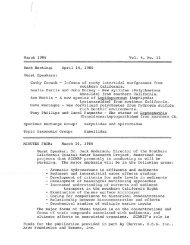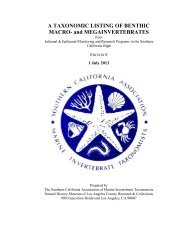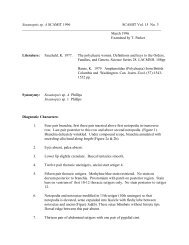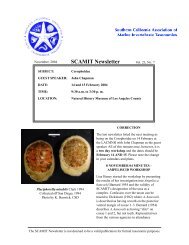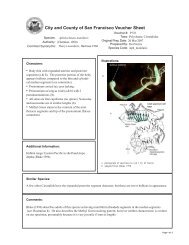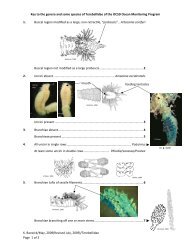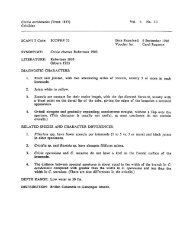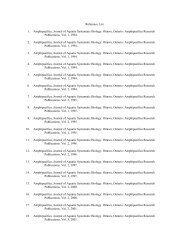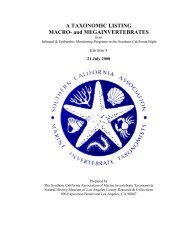SCAMIT Newsletter Vol. 23 No. 10 2005 February
SCAMIT Newsletter Vol. 23 No. 10 2005 February
SCAMIT Newsletter Vol. 23 No. 10 2005 February
Create successful ePaper yourself
Turn your PDF publications into a flip-book with our unique Google optimized e-Paper software.
<strong>February</strong>, <strong>2005</strong> <strong>SCAMIT</strong> <strong>Newsletter</strong> <strong>Vol</strong>. <strong>23</strong>, <strong>No</strong>. <strong>10</strong>SUBJECT:TBAGUEST SPEAKER:DATE:TBA (the 9 May Polyclad Flatworm meeting withTony Phillips has been postponed; periodically checkthe website for upcoming meeting announcements)TIME: 9:30 a.m. to 3:30 p. m.LOCATION:FEBRUARY COROPHIID WORKSHOPJohn Chapman distributed his bibliography forLight’s Manual, complete with references to allcitations for each species listed in theAmphipod chapter. He also distributed draftkeys for the families Corophiidae, Isaeidae,Ischyroceridae, Aoridae, Ampithoidae,Podoceridae, Ampeliscidae, Phoxocephalidae,and Haustoriidae for beta-testing by theparticipants. He’s hoping for feedback andcorrections and/or additions from us all.Rudilemboides stenopropodusphoto by D. Pasko, CSDDuring the initial discussion/introduction andsummary of the project, several problem taxawere mentioned.John believes that Sinocorophium japonicum(Hirayama 1984) (=Corophium volutatorjaponica Hirayama 1984) may be the same asCorophium multisetosum Stock 1952.The <strong>SCAMIT</strong> <strong>Newsletter</strong> is not deemed to be a valid publication for formal taxonomic purposes.
<strong>February</strong>, <strong>2005</strong> <strong>SCAMIT</strong> <strong>Newsletter</strong><strong>Vol</strong>. <strong>23</strong>, <strong>No</strong>. <strong>10</strong>He also suspects that Pachynella lodo J. L.Barnard 1964 and Pachynus barnardi Hurley1963, are the same species, and represent maleand females. His perception is due to theoverall similarity in body and gnathopods ofthese two and to his experience of alwaysfinding them together in samples. Protandry inlysianassoids has been established for variousspecies. Don Cadien will discuss this later inthis newsletter.The reliance of presence/absence of seta todistinguish species of Jassa (see Conlan 1989,1990) is questionable since Jassa (and manyischyrocerids) have complex life histories thataffect morphology (e.g., the number of femalespresent in a population affects malemorphology).Over the next two days, reviews of specimensand Light’s Manual chapters produced some ofthe following conclusions:CorophiidaeSpecimens of Hirayamaia mortoni (Hirayama1986) from Gray’s Harbor (originally identifiedby Dean Pasko) were reviewed and consideredto be Monocorophium acherusicum (Costa1857). The potential mis-identificationsresulted from a urosome without lateralnotches. The absence of this notch lead to theconclusion that uropod 1 was “mainly”ventrally inserted, leading to the genericidentification of Hirayamaia using the key inBousfield and Hoover (2002).Monocorophium,by contrast, is defined ashaving a notch for the lateral insertion ofuropod 1. Images were taken of the twocontrasting conditions, and in the end, therewas general agreement that the Gray’s Harborspecimens possessed a urosome where thelateral notch was not apparent. However, JohnChapman explained that those genera withtruly “ventral” insertions of uropod 1 haveurosomites with upturned lateral margins (e.g.,Laticorophium). Initial review of H. mortoni at2the meeting indicated that it had a very similarspine pattern to that of M. acherusicum. Deanwill review additional specimens to verify thisand report on his results.Specimens from Gray’s Harbor and theBight’03 survey previously identified as M.acherusicum, M. insidiosum (Crawford 1937),and Americorophium salmonis (Stimpson1857) were taken through John’s key, and theidentifications confirmed. The characters thatJohn employed included patterns of antennalspination, among others, and were generallyeasy to interpret. For example, several closelyrelated species that tend to co-occur (M.acherusicum, M. insidiosum, M. uenoi(Stephensen 1932), and A. brevis (Shoemaker1949)) can all be separated by the pattern ofspines that line the ventral margin of antenna 2.Several specimens of Corophiumheteroceratum Yu 1938, were also reviewed.Jim Roney brought some specimens from LAHarbor originally identified as Sinocorophiumsp. These were large specimens that wereoriginally considered to have fused urosomites.Upon re-examination, those involveddetermined that the ursomites were separate,and the specimens then easily keyed to C.heteroceratum. These large specimens showedan additional, distal tooth on the inner marginof antenna 1, article 1. Other specimens of C.heteroceratum from San Francisco Bay had asingle tooth located mid-way along the lengthof the article. Carol Paquette broughtspecimens from Long Beach Harbor that alsohad one tooth, except for one relatively largespecimen that had a distal “bump” that wasinterpreted as being an emerging process/tooth.Chapman maintains that the genusSinocorophium erected by Bousfield & Hooveris invalid and must be ignored.PhoxocephalidsDean commented that he questioned thevalidity of Foxiphalus cognatus (J. L. Barnard1960). LACNHM specimens identified as F.cognatus were considered late Monday
<strong>February</strong>, <strong>2005</strong> <strong>SCAMIT</strong> <strong>Newsletter</strong><strong>Vol</strong>. <strong>23</strong>, <strong>No</strong>. <strong>10</strong>evening. The first lot (Lot 81925, BF-1)included two specimens that turned out to beRhepoxynius sp (not taken further) and F.golfensis J. L. Barnard & C. M. Barnard 1982.The second lot (Lot 81921, BF-1) included asingle specimen of F. obtusidens (Alderman1936). Dean contends that there has not yetbeen a “true” F. cognatus identified in samplesfrom southern California other than theoriginal. Barnard and Barnard (1982)commented that upon reexamination of theholotype, F. cognatus differed from F. similis(J. L. Barnard 1960) by the smaller epistomalcusp and a stouter displaced spine on themolar, adding: “…but no other qualitativedifferences are apparent.” Every lot of F.cognatus that Dean has seen at the LACNHM(several have been examined), and everyspecimen reviewed as part of the three regionalsampling efforts, have turned out to representother species, and most commonly F.obtusidens with slightly produced but pointedepistomes. The holotype of F. cognatus wasreviewed and commented on by <strong>SCAMIT</strong> inOctober 2001 (see <strong>SCAMIT</strong> NL <strong>Vol</strong>ume 20,<strong>No</strong>. 6).Foxiphalus obtusidens and Majoxiphoxusmajor (J. L. Barnard 1960) were considered.Museum specimens identified as F. obtusidensmajor were examined and compared to othersidentified as F. obtusidens. The “major”specimens were significantly larger than thelargest F. obtusidens, although some equallysized specimens were found and compared. Acouple of distinguishing characters wereconfirmed. M. major has a maxilliped palpwith an “inflated” article 2 relative to F.obtusidens and the illustrations that Johnselected for Light’s Manual clearly showed thisdifference. Additionally, the placement of apair of plumose setae on the telson differed. InM. major these setae are positioned extremelybasally on the telson–approximately one setallength from the base–and hidden by the upward(dorsal) extension of urosomite 3 that3surrounds the base of the telson. In F.obtusidens the setae are positioned muchfurther away from the base of the telson andbeyond urosomite 3 extensions.IschyroceridaeIschyrocerus anguipes Krøyer 1838 and I.pelagops J. L. Barnard 1962 were reviewed byRon Velarde and John. I. anguipes isdistinguished by few (3–5) large teeth, plus thelarge slightly re-curved imbedded distal spineon the outer ramus of uropod 3. In addition, I.anguipes has a uropod 3 outer ramus that is 1.5times the thickness of the inner ramus. I.pelagops was found to have 6–8 smaller teethon the outer ramus of uropod 3, a smallerdistal, imbedded spine that was nearly straight,and the two rami were similar in thickness.John feels that these two species are equivalentto the Ischyrocerus sp A and sp B of Barnard(1967).Some members of the group neededclarification of what distinguishes Jassa fromIschyrocerus. John described Jassa as being astout, squat Ischyrocerus. Jassa isdistinguished in possessing a stout, distinctlyhooked spine imbedded in the outer ramus ofuropod 3 and several irregularly sized teeth.There was no discussion of Microjassa orNeoischyrocerus during the workshop (seeConlan, 1995 concerning these two genera inthe NEP). Several Microjassa are included inthe new key, but Neoishyrocerus claustris (J. L.Barnard 1969) does not fall within thegeographic coverage of Light’s Manual.AoridaeThe Protomedia articulata “complex” wasconsidered. After some discussion, review ofthe literature and specimens from CSD, it wasdetermined that males can reliably be identifiedusing the key in Conlan (1983), while thefemales were currently indistinguishable. JimRoney pointed out the utility of the tooth on theinner margin of coxa 2 of male P. prudens J.L.Barnard 1966, (see Conlan 1983: Figure 15,
<strong>February</strong>, <strong>2005</strong> <strong>SCAMIT</strong> <strong>Newsletter</strong><strong>Vol</strong>. <strong>23</strong>, <strong>No</strong>. <strong>10</strong>whole animal, page 31; couplet 6, page 26).This process is absent in P. articulata J. L.Barnard 1962. Several lots of CSD specimenswere examined, and all but the smaller,immature males possessed this tooth on coxa 2.What members need to do now is find sampleswith male P. articulata (or other species)accompanied by females and compare thefemales for differences that may be used todistinguish the species. Jim also pointed to thedifferences between P. articulata and P.prudens and relationship of antenna 1, article 3relative to article 1. In P. articulata, article 3 isgreater than half the length of article 1 (seeConlan 1983: page 27 and Figure 12, page 28),where as in P. prudens article 3 is distinctlyless than one-half of article 1 (see Figure 15,page 31, and diagnosis, page 33).In an email correspondence, Sandy Lipovskyof British Columbia said that she finds male P.articulata and P. grandimana Brüggen 1905.John C. commented that he believed P.grandimana to represent a late-stage P. fasciataKrøyer 1842. However, a quick review ofFigures 13 and 14 (Conlan 1983: pages 29 and30, respectively), revealed that P. grandimanahas stout spines on uropod 3 where P. fasciatahas thin setae. Perhaps Sandy can help resolvethese questions.Aoroides secundus Gurjanova 1938 collectedby CSD during Bight’98 were reviewed andconfirmed using John’s Aorid key and figuressupplied by Lisa Haney and Don Cadien. A.secundus can be distinguished from the otherspecies included in <strong>SCAMIT</strong> Ed 4 Species List(i.e., A. columbiae Walker 1898, A. intermediaConlan and Bousfield 1982, A. inermis Conlanand Bousfield 1982, A. exilis Conlan andBousfield 1982, A. spinosa Conlan andBousfield 1982, and Aoroides sp A <strong>SCAMIT</strong>1996) by the absence of a distal process onuropod 2 peduncle, and the combination ofsetal bundles on the dorsal margin of article 5of male gnathopod 1, which is also wider thanthe basis. This combination (setose article 5wider than the basis) is unique among the six4species recorded in <strong>SCAMIT</strong> Ed 4 or describedin Conlan and Bousfield (1982) (See Figure 11,page 95). A. secundus was also contrasted withAoroides sp A, which has a very reduced interramalprocess on uropod 2 that is difficult tosee and sometimes interpreted as being absent.Aoroides sp A differs by the absence of setaeon the anterior margin of article 5 on malegnathopod 1 and an article 5 that is equal inwidth to the basis. In addition, Aoroides sp A isunique in having a mandibular palp article 2that is bare and uropod 3 rami without stoutspines.Jim Roney brought specimens ofRudilemboides stenopropodus J. L. Barnard1959 for review. These specimens representedmales that were larger than those used in theoriginal description and show a distinctwidening of the basis in males. This characterwas not noted by J. L Barnard in his originaldescription (Barnard in J. L. Barnard and Reish1959), and caused these specimens to beoriginally designated as a provisional species(Rudilemboides sp HYP1) during Bight’98.Specimens of Rudilemboides sp A <strong>SCAMIT</strong>1998 were also considered. It is distinguishedby the single large tooth on articles 5 and 6 ofmale gnathopod 1. Unfortunately, however, thefemales of the two species remainindistinguishable, although R. stenopropodus islargely a bay species found no deeper than 20m, while Rudilemboides sp A is a coastal shelfspecies found between 25–270 m. A vouchersheet for the species is available at the<strong>SCAMIT</strong> website, taxonomic tools section.IsaeidaeAfter polling those in the room about theirusage of his key to SCB Photis, Dean said thathe would go through with a planned revisionthat will update problematic characters,incorporate editorial suggestions from pastusers, and include a couple of additionalprovisional taxa.
<strong>February</strong>, <strong>2005</strong> <strong>SCAMIT</strong> <strong>Newsletter</strong><strong>Vol</strong>. <strong>23</strong>, <strong>No</strong>. <strong>10</strong>THE SECOND DAYOn the second day, before we considered thecorophioid revision, Vice-President LeslieHarris presented a very interesting report onher recent activities in Fiji. Her class forUniversity of the South Pacific and NaturalResources staffers was well attended andreceived. Over the five days of the class/workshop the students had a fairly thoroughreview of the living appearance of reef relatedinvertebrates through Leslie’s extensivecollection of live photographs (her own, aswell as some from the internet), spent severaldays in the field collecting, and spent severaldays in the lab working up their samples. Muchremains for future interactions, but the groupwas both receptive and enthusiastic. One of themost important possible outcomes of such tripsby highly trained taxonomists and fieldecologists, is the training of a local cadre ofworkers to participate in further informationgathering. Local expertise is of great value, andsuperior to intermittent visits by foreignspecialists.The ARMs (Artificial Reef Modules) deployedthere last year were partially harvested this trip.They had a very different type of inhabitantthan seen when these structures werepreviously deployed in the British VirginIslands. Much of the difference resulted fromthe amount of silt input into the bay by erosionfrom the highlands. This is the same type ofeffect expected with the large constructionproject planned for the Bay, but has alreadybeen going on for many years. In consequencethere are high volumes of suspended silt insome areas, and the cavities of the ARMs werelargely silted in. Only in the reference site leastaffected by siltation was the communityrelatively normal, with high diversity andbiomass.5The hosts took very good care of theresearchers, who had welcoming or celebrationdinners and kava ceremonies every timeanything happened. It is surprising anyonecould get work done. The rainy season madetransport a bit of a problem too, but enoughpeople can push a Land Rover out of the mud.MEYERS AND LOWRY 2003Meyers and Lowry’s 2003 re-arrangement ofthe Corophiidea was considered. Don firstpresented a table of how the proposedreclassification would affect the <strong>SCAMIT</strong> Ed 5species listing. Few of the members werehappy with the proposed changes. Among othercriticisms, such as having over 50% ofidentified clades based on homoplasy, thepaper was generally criticized for not beingvery representative of natural variation within agroup (i.e., not including more than one taxaper genus), and not being wholly representativeof the taxa that comprise various families andgenera used in the analysis. Todd Haney, withthe help of Regina Wetzer, re-entered the datamatrix used in Meyer and Lowry’s publicationand performed a second analysis. Toddpresented the results of this abbreviatedanalysis (short run time) in the form of anunrooted strict consensus tree rather than amost parsimonious tree. Their analysis differedin some significant ways from that presentedby Meyers and Lowry, although both sharedthe same high level clades. In short, adoptionof the proposed re-classification wasconsidered premature. It is a provocativepreliminary analysis, albeit, with wellsupported major clade structure. It should beconfirmed or modified by reanalysis usingbroader taxon sampling in poorly representedclades, and with a reconsideration of charactersused. The dominance of characters whichreflect convergence in the analysis renders theresults difficult to interpret with confidence.Other characters with less ambiguousphylogenetic information should be sought.Perhaps inclusion of molecular data in acombined evidence analysis could circumvent
<strong>February</strong>, <strong>2005</strong> <strong>SCAMIT</strong> <strong>Newsletter</strong><strong>Vol</strong>. <strong>23</strong>, <strong>No</strong>. <strong>10</strong>the character convergence problem. Thispreliminary analysis gives us plenty to consideras we await further attempts at resolution ofthis thorny issue. At the least we should givethought to the well supported caprellidan cladewhich included the ischyrocerid, photid, isaeid,cyamid, podocerid, dulichiid, andneomegamphopid clades (among others) alongwith the caprelliid clade.Another recent cladistic analysis of a largeinfraordinal group of families by Serejo (2004),who analyzed the talitroideans, can fruitfullybe compared with Myers and Lowry.Comparison of the degree of homoplasy andhow it influences the analysis may be of valuein deciding how much is too much.At the end of the workshop on the 15 th , JohnByrne (CSDMWWD), distributed a new key tothe Bathymedon of southern California andDean Pasko (CSDMWWD) distributed a key tothe species of the Monoculodes complexrecorded by <strong>SCAMIT</strong> member agencies. We alllook forward to applying these new tools to ourspecimens.ARE PACHYNUS AND PRACHYNELLATHE SAME SPECIES?D. Cadien, CSDLACFurther consideration of John Chapman’ssuspicion that Pachynus barnardi Hurley 1963and Prachynella lodo (J.L. Barnard 1964) wereconspecific is warranted. First of all, thosepresent at the workshop other than John did notshare his experience that the two always occurtogether. Quite the contrary, our recollectionswere that they almost never occur together.This will need to be checked against past databefore it can be confirmed.The literature on protandrous hermaphroditismin lysianassoids is not voluminous. Evidence isbest presented by Lowry and Stoddart (1986),and deals with the conicostomatin group, asmall portion of the overall lysianassoids.Lowry and Stoddart (1997) also mention6protandry as a possible explanation for thepresence of two male morphs of their newgenus and species Eclecticus eclecticus. Theyconclude that while this may represent a caseof protandrous hermaphroditism, the evidenceis not yet available to support such ajudgement. They place Eclecticus among theLysianassidae sensu stricto, in theLysianassinae. While the family level analysisof the lysianassoids discussed by Lowry andStoddart 1983 is not yet finalized a number ofworking “groups” which may eventually berecognized as family - or subfamily-level taxaare in use. The conicostomatins is one of these.Since the case for Eclecticus is not proven, theconicostomatins are the only group withestablished life history patterns of protandroushermaphroditism. Neither Pachynus norPrachynella are within this group. They areinstead in the pachynid group (Lowry 1984).The closeness of relationship between thevarious groups of lysianassoids has yet to bedetermined, but this group is treated as a fullfamily by Myers, McGrath & King (<strong>2005</strong>) (seewww.amphipoda.com).Lowry (1984) subdivides the pachinids intotwo groups based on the nature of the terminalspines on maxilla 1. Pachynus falls into onegroup, and Prachynella into the other. Thegenera Sheardella and Drummondia are mostclosely related to Prachynella on the basis ofmaxilla morphology, and both have elongatebodies, but this elongate body morphology alsooccurs in the other group (e.g. Figorella). Itremains possible that the present taxonomyreflects too much splitting on too insignificantgrounds, and that different sexes of a singlespecies may have been placed in differentgenera. <strong>No</strong>ne of these animals have beensampled in large numbers so that a clear idea ofdevelopmental trends between molts can betraced. The hypothesis John suggested can onlybe definitively disproven by demonstration offemales having the morphology of Pachynusbarnardi and females having the morphologyof Prachynella lodo, or the equivalent formales. This awaits the time to revisit past
<strong>February</strong>, <strong>2005</strong> <strong>SCAMIT</strong> <strong>Newsletter</strong><strong>Vol</strong>. <strong>23</strong>, <strong>No</strong>. <strong>10</strong>collections and seek such animals. If somereader finds the material to show that themorphology of these two is not related to sex,please notify both John Chapman(john.chapman@oregonstate.edu), and DonCadien (dcadien@lacsd.org).A follow-up note will be prepared oncecollections have been revisited and evidencehas been tabulated regarding occurrence andsex of individuals taken by local agencies. DonCadien (CSDLAC)DENSE LIVINGTom Parker – CSDLACInfrequently invertebrate specimens willcontain endoparasitic or symbiotic polychaetes.Martin and Britayev (1998) authored a majorwork on these and other polychaete symbioticrelationships.Parasitic Drilonereis specimens (Oneonidae)are sometimes collected while buried insideand also partially extruded from their hostworms. Typically these parasites are found inCirratulidae hosts such as Aphelochaeta sp.They are striking, as their body size is oftenequal to or greater than their host worm. Thiscondition was illustrated and discussed in the<strong>SCAMIT</strong> voucher sheet of Drilonereis sp Afrom newsletter volume 16 (<strong>10</strong>). Taxonomicidentifications of these specimens have beenuncertain due to the morphological changesthat occur when a worm migrates to its freelivingcondition. Poulin (2001) also examinedthe changes in body size and segmentationdensity of endoparasitic oneonids. From hisobservations, Poulin concluded thatendoparasitic forms have more segments andsmaller segments than free-living oneonids.Attached at the end of the newsletter is animage of a Drilonereis specimen making itsdebut from a novel host species (Fig. 1). Thisparasite is emerging from the paraonid worm,Aricidea (Acmira) horikoshii. Posteriorly there7is a second burst site in the host body wall.Also included is an image of a Drilonereisemerging from a sabellid host, Chone mollis(Fig. 2).Hartman described the polychaete Capitellacapitata ovinocola as living clumped insidegelatinous egg masses from squid. A recentcollection of squid eggs contained dozens ofthe nereid worm, Platynereis bicanaliculata.This is likely the first record of a squid eggmass habitat for Platynereis. Attached is aphotograph of one specimen with an unhatchedsquid (Fig. 3). Also included is an image of thisnereid’s distinctive notosetae (Fig. 4). Whenalive, these worms were observed activelymoving thru the gelatinous material inside thesquid egg mass.JOB OPPORTUNITIESLarval Fish Taxonomist - PreliminaryPosition DescriptionMote anticipates hiring a larval fish taxonomistin the coming months. The position may beneeded as early as April <strong>2005</strong>. This is a fulltime position including fringe benefits and willbe offered for a minimum of one year withadditional years possible depending on annualperformance evaluation and funding. Salaryrate will be based on a senior biologist rate andwill be commensurate with experience. Musthave either a Masters degree or a Bachelorsdegree with at least 1 year of experienceworking with ichthyoplankton and otherzooplankton. Applicant must be either a U.S.citizen or U.S. resident with a valid green card.Responsibilities include supervision ofplankton collections in southwest Florida baysand estuaries and at power plants. Thesuccessful applicant will need to be familiarwith plankton sampling techniques, laboratorysample sorting and identification protocols forcollection, enumeration and identification oflocal estuarine ichthyoplankton and somelarval stages of commercially or recreationallyimportant invertebrates. Other duties include
<strong>February</strong>, <strong>2005</strong> <strong>SCAMIT</strong> <strong>Newsletter</strong><strong>Vol</strong>. <strong>23</strong>, <strong>No</strong>. <strong>10</strong>the supervision of plankton sorters,identification of ichthyoplankton and selectedzooplankton to the lowest possible taxon,selected zooplankton measurements, andenumeration. Familiarity with data entry,flowmeter calibration, and a basic statisticalbackground very helpful.Mote Marine Laboratory is a private nonprofit501(c)(3) research and educational institutionlocated in Sarasota, Florida. <strong>No</strong>rmallaboratory hours involve an 8 hour day from8:00 am to 5:00 pm with an hour lunch from12:00 pm to 1:00 pm. Field work may involvesome overnight work and odd hours. Must beavailable to travel frequently to sampling sitesand have or be able to obtain a valid Floridadrivers licence.Applicant must be able to trailer and operate asmall outboard boat and be able to lift allsampling gear, pumps, and samples.Contact: Karen BurnsMote Marine Laboratory1600 Ken Thomson Parkway,Sarasota, Florida 34<strong>23</strong>6(941) 388-4441x<strong>23</strong>6, Fax (941) 388-4312kburns@mote.orgThe ideal candidate should have a Ph.D. or bevery close to having finished his/herdissertation. Specialization within paleontologyis open, though it would be helpful if thecandidate could pursue some field research inthe American West. The candidate should havea background and experience in collectionmanagement and curation.The school is interested in recruiting quicklyand looking for a candidate who would beavailable immediately or as soon as possible.Interested candidates should contact:Karl Hutterer, Executive DirectorSanta Barbara Museum of Natural History2559 Puesta del Sol RdSanta Barbara, CA 93<strong>10</strong>5Phone: (805)682-4711 ext. <strong>10</strong>1Fax: (805)569-3170E-mail: khutterer@sbnature2.org.Paleontology Collections & TeachingPositionThe Santa Barbara Museum of Natural Historyis collaborating with a private school in aneffort to create a “museum school” thatendeavors to inspire in students a passion forscience through hands-on engagement.Students will work with collections andscientists on the full range of collections careand research activities that typically occur innatural history museums. In this context, weare looking for a dynamic paleontologist who,besides his/her research ambition, also has agenuine interest in working with high schoolstudents and fully engage them in his/her work.8
<strong>February</strong>, <strong>2005</strong> <strong>SCAMIT</strong> <strong>Newsletter</strong><strong>Vol</strong>. <strong>23</strong>, <strong>No</strong>. <strong>10</strong>BIBLIOGRAPHYBarnard, J. Laurens. 1969a. Gammaridean Amphipoda of the rocky intertidal of California:Monterey Bay to La Jolla. United States National Museum, Bulletin, no. 258: 1-<strong>23</strong>0.Barnard, J. Laurens, and Donald J. Reish. 1959. Ecology of Amphipoda and Polychaeta ofNewport Bay, California. Allan Hancock Foundation Publications, Occasional Paper, no.21: 1-<strong>10</strong>6.Barnard, J.L. and C.M. Barnard. 1982. Revision of Foxiphalus and Eobrolgus (CrustaceaAmphipoda: Phoxocephalidae) from American Oceans. Smithsonian Contributions toZoology. <strong>No</strong>. 372. 35pp.Bousfield, Edward L., and Phillip M. Hoover. 1997. The amphipod superfamily Corophioidea onthe Pacific coast of <strong>No</strong>rth America. V. Family Corophiidae. Corophiinae, new subfamily.Systematics and distributional ecology. Amphipacifica 2, no. 3: 67-139.Conlan, Kathleen E. 1983. The amphipod superfamily Corophioidea in the northeastern Pacificregion. 3. Family Isaeidae: systematics and distributional ecology. National Museums ofCanada Publications in Natural Sciences, no. 4: 1-75.———. 1989. Delayed reproduction and adult dimorphism in males of the amphipod genus Jassa(Corophioidea: Ishyroceridae): an explanation for systematic confusion. Journal ofCrustacean Biology 9, no. 4: 601-25.———. 1990. Revision of the crustacean amphipod genus Jassa Leach (Corophioidea:Ischyroceridae). Canadian Journal of Zoology 68: 2031-75.———. 1995. Thumbing doesn’t always make the genus: revision of Microjassa Stebbing(Crustacea: Amphipoda: Ischyroceridae). Bulletin of Marine Science 57, no. 2: 333-77.Conlan, Kathleen E., and Edward L. Bousfield. 1982. Studies on amphipod crustaceans of the<strong>No</strong>rtheastern Pacific region. I. 3. The superfamily Corophioidea in the <strong>No</strong>rth Pacificregion. Family Aoridae: systematics and distributional ecology. National Museums ofCanada, Publications in Biological Oceanography, no. <strong>10</strong>: 77-<strong>10</strong>1.Lowry, James K. 1984. Systematics of the pachynid group of lysianassoid Amphipoda(Crustacea). Records of the Australian Museum 36, no. 2: 51-<strong>10</strong>5.Lowry, James K., and Helen E. Stoddart. 1983a. The shallow-water gammaridean Amphipoda ofthe subantarctic islands of New Zealand and Australia: Lysianassoidea. Journal of theRoyal Society of New Zealand 13, no. 4: 279-394.———. 1986. Protandrous hermaphrodites among the lysianassoid Amphipoda. Journal ofCrustacean Biology 6: 742-48.———. 1997. Amphipoda Crustacea IV. Families Aristiidae, Cyphocarididae, Endevouridae,Lysianassidae, Scopelocheiridae, Uristidae. Memoirs of the Hourglass Cruises 9, no. 1: 1-147.Martin, D., T. A. Britayev. 1998. Symbiotic Polychaetes: a review of known species.Oceanography and Marine Biology, An Annual Review (36): 217-340.Myers, Alan A., and James K. Lowry. 2003. A phylogeny and a new classification of theCorophiidea Leach, 1814 (Amphipoda). Journal of Crustacean Biology <strong>23</strong>, no. 2: 443-85.Poulin, R. 2001. Body size and segmentation patterns in free-living and parasitic polychaetes.Canadian Journal of Zoology (79): 741-745.Serejo, Cristiana S. 2004. Cladistic revision of talitroidean amphipods (Crustacea, Gammaridea),with a proposal of a new classification. Zoologica Scripta 33, no. 6: 551-86.9
<strong>February</strong>, <strong>2005</strong> <strong>SCAMIT</strong> <strong>Newsletter</strong><strong>Vol</strong>. <strong>23</strong>, <strong>No</strong>. <strong>10</strong>Please visit the <strong>SCAMIT</strong> Website at: http://www.scamit.org<strong>SCAMIT</strong> OFFICERS:If you need any other information concerning <strong>SCAMIT</strong> please feel free to contact any of theofficers at their e-mail addresses:President Kelvin Barwick (619)758-<strong>23</strong>37 kbarwick@sandiego.govVice-President Leslie Harris (213)763-3<strong>23</strong>4 lharris@nhm.orgSecretary Megan Lilly (619)758-<strong>23</strong>36 mlilly@sandiego.govTreasurer Cheryl Brantley (3<strong>10</strong>)830-2400x5500 cbrantley@lacsd.orgBack issues of the newsletter are available. Prices are as follows:<strong>Vol</strong>umes 1 - 4 (compilation).................................$ 30.00<strong>Vol</strong>umes 5 - 7 (compilation).................................$ 15.00<strong>Vol</strong>umes 8 - 15 ................................................ $ 20.00/vol.Single back issues are also available at cost.The <strong>SCAMIT</strong> newsletter is published monthly and is distributed freely through the web site atwww.scamit.org. Membership is $15 for the electronic copy available via the web site and $30to receive a printed copy via USPS. Institutional membership, which includes a mailed printedcopy, is $60. All new members receive a printed copy of the most current edition of “ATaxonomic Listing of Soft Bottom Macro- and Megainvertebrates … in the Southern CaliforniaBight.” The current edition, the fourth, contains 2,067 species with partial synonyms. Allcorrespondences can be sent to the Secretary at the email address above or to:<strong>SCAMIT</strong>C/O The Natural History Museum, Invertebrate Zoologyattn: Leslie Harris900 Exposition BoulevardLos Angeles, California, 90007
“Dense Living” - T. Parker, Associated FiguresFigure 1. Drilonereis emergingfrom Aricidea (Acmira)horikoshiiFigure 2. Drilonereis emergingfrom Chone mollisFigure 3. Platynereis bicanaliculatawith an unhatched squidFigure 4. <strong>No</strong>toseta of P. bicanaliculata



